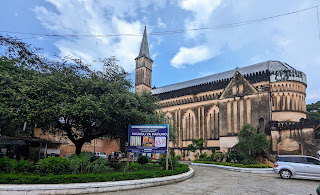 |
| Former Slave Market at Stone Town Zanzibar, Tanzania |
The grey skies with rain and muddy streets contributed to the somber mood I experienced at this memorial to the former slaves who were beaten and brought from miles away to this market area on the island of Zanzibar off the coast of Tanzania.
The life-sized statues were created by Clara Sornas of Scandinavia in 1998. The figures bear original chains.
The former site is on the grounds of the Anglican Cathedral, the Church of Christ.
After our visit to the church and the former slave market, we returned to the dock along the narrow alleys where people sold food, spices, and arts and crafts.
About East African Slavery and the Market
The market from the 1800s was one of the last markets. The slaves were packed in small underground rooms with no food or toilets. They were brought up to the market in order of their size then secured to a tree where they were whipped as a test of their ability to withstand pain.
A lot can be learned about the African slave trade in the small museum on the grounds. The history of slavery in this part of Africa can be found at Africanlanders.com. The history dates back before the middle ages. The slaves were from different cultural groups on the mainland, spoke different languages, and fought intergroup battles.
When Arab and European explorers arrived, powerful groups captured people from other groups and sold them to the traders who transported them to Zanzibar. For some, the journey was long, difficult, and painful. They might walk as long as 15 days in a row. They were given little food or water. Along the route to the coast, some slaves were sold to other traders. And some died.
The Africanlanders.com website offers the following story.
Thomas Smee, commander of the British research ship Ternate, describes in 1811: “The show starts around 4pm. The slaves come out prepared with their skins clean and smeared with cocoa nut oil, their faces painted red with white lines and their hands, nose, ears and feet decorated with gold and silver bracelets and rings. At the beginning of the row, made up of both sexes and classified by age -in ages between 6 and 60 years old- and from youngest to tallest, walks the person who owns those slaves accompanied by two domestic slaves who act as guard. When the procession of slaves around the market begins, at the slightest interest of a spectator, the line stops and the process of examining the slave concerned begins: check that there is no “defect” in speech, the ear and its limbs; that he has no palpable disease; and examines the mouth, the teeth, and all parts of the body…” Some slaves were whipped in public to see which was the strongest and could be sold at a higher price. Others were kept in low and small rooms for many days so that only those who endured in these very poor conditions remained.
Unfortunately, slavery continues and most slaves are women according to the UNSW Australian Human Rights Institute. https://www.humanrights.unsw.edu.au/research/modern-slavery.







Comments
Post a Comment